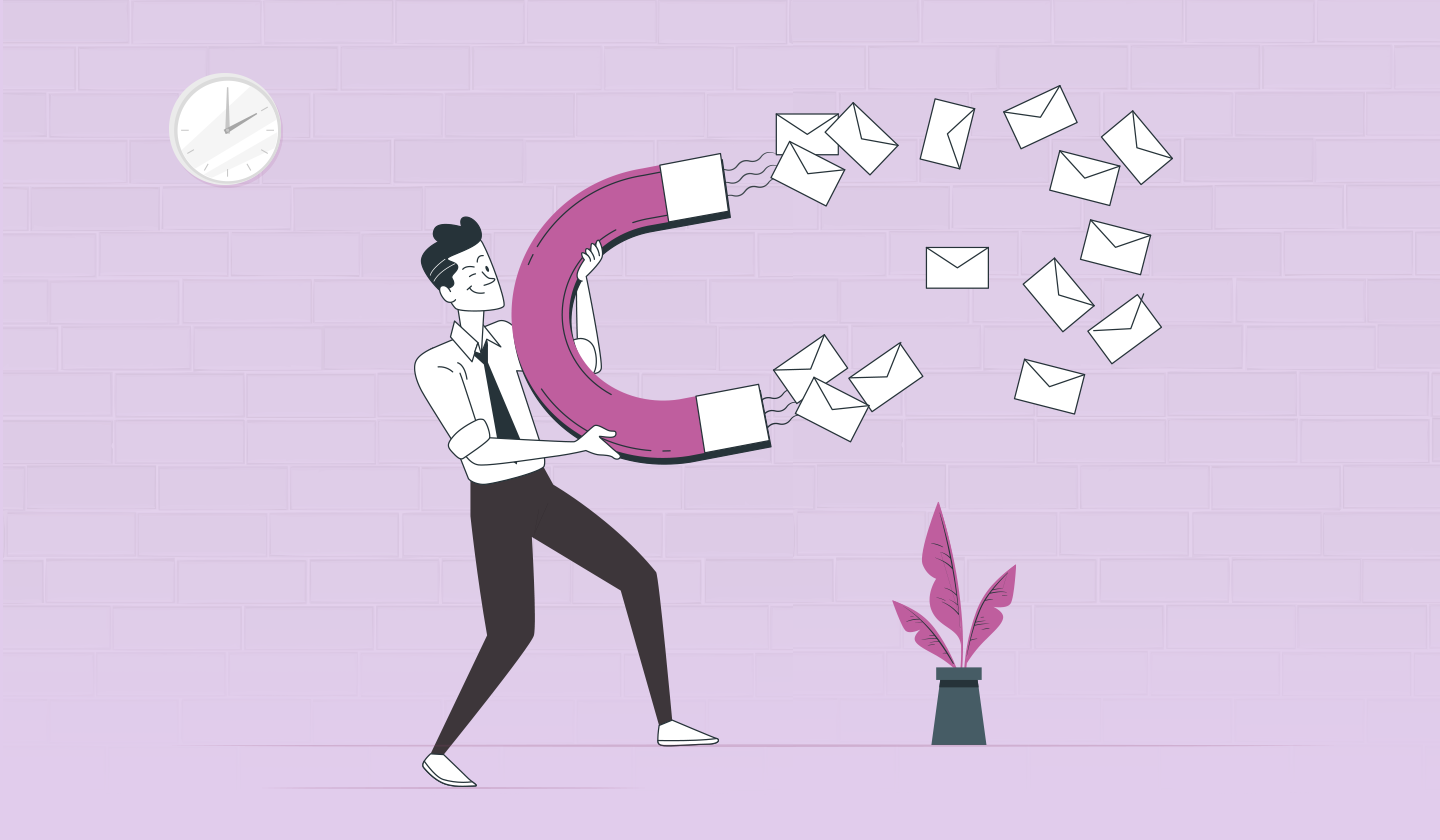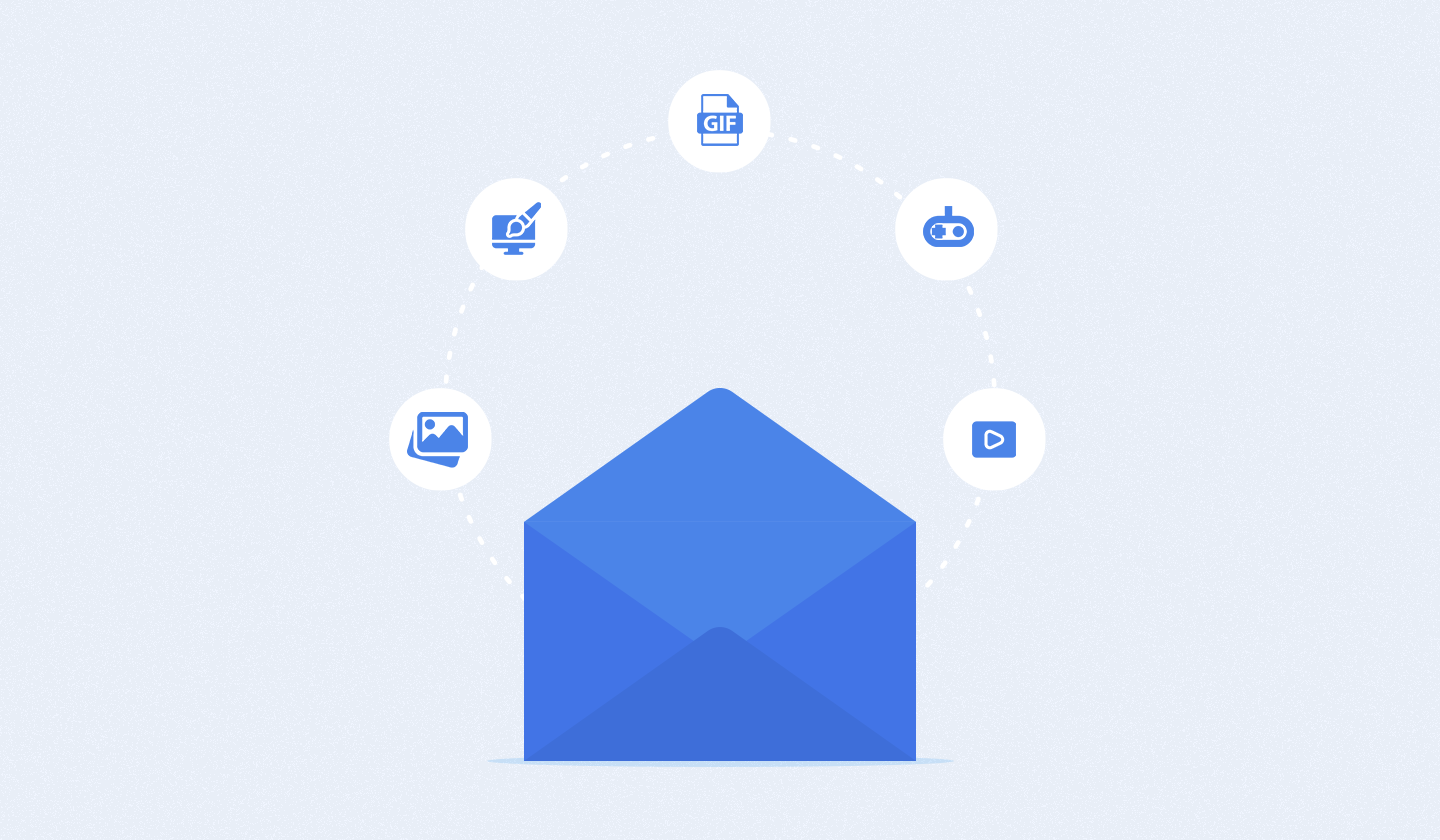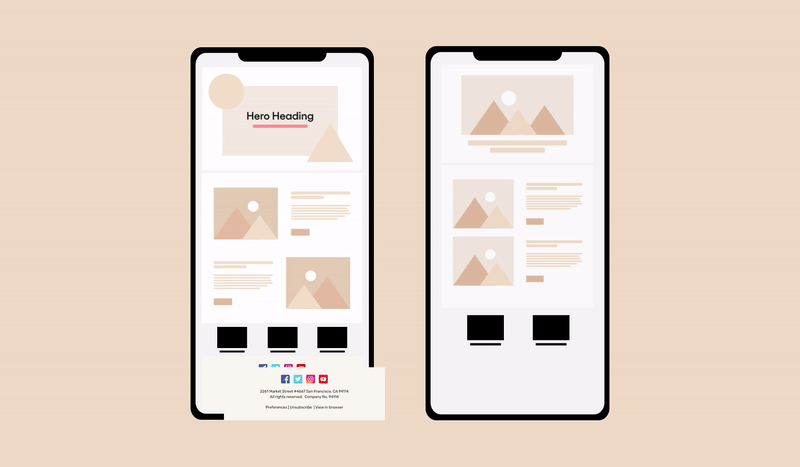Email marketing isn’t just about you. Yes, you have goals for your team and business, but you’ll never reach them unless you convey what’s in it for your audience.
Keeping your audience at the core of all your efforts is really the key to successful email marketing and, consequently, email engagement. Still, how to ensure that your emails stand out in your customers' crowded inboxes?
We know that finding a tactic that works is easier said than done. It is specifically tricky to narrow down what a successful email engagement strategy looks like for your organization.
So, we’ve laid down everything you need to know about email engagement in this guide.
First, let’s look at what email engagement means.
What Is Email Engagement?
Email engagement is defined as a measure of how recipients interact with your emails.
You can monitor your email engagement by assessing several necessary metrics like bounce rate, click-through rate, conversion rate, etc.
Email Engagement Metrics Every Marketer Needs to Know
Here are a few of the top engagement metrics we’ve found to be the most important for your prospective email campaigns.

Bounce rate
The bounce rate determines how many subscribers didn’t receive your email and affects the overall success of your marketing campaigns. Therefore, it is relevant to track the bounce rate for successful email engagement. There are two types of bounce rates: soft bounces and hard bounces.
Soft bounces trace temporary problems with email addresses, whereas hard bounces track permanent issues with email addresses.
How to measure bounce rate?
You can measure the bounce rate against the open rate, as it will give you a more accurate idea of the quality of your subscriber list. If you have higher hard bounces, it means your list may be full of old, fake, or incorrect email addresses.
Here’s a simple formula to calculate your email bounce rate.

How to decrease thebounce rate?
The email bounce rate can be lowered by requiring a double opt-in from your subscribers. Double opt-in asks them to verify their email addresses and confirm that they want to receive emails from your brand.
Open rate
This metric has long been considered one of the simplest metrics used by email marketers. It tracks the percentage of subscribers who open a specific email, giving you insight into how engaged your subscribers are and how effective different subject lines are.
Having said that, the open rate has become a relatively unreliable metric because Apple’s Mail Privacy Protection feature has put its future in jeopardy.
The feature effectively disables open tracking for users who opt in to use it. With more inbox providers following suit, open rates will only become more and more unreliable.
However, there are plenty of other metrics on the list to track the success of your email marketing campaigns.
Click-Through Rate (CTR)
CTR is another common metric to determine how engaging your email campaigns are. It simply measures how many people clicked on the links in your email.
For instance, if you included a link to redeem a specific offer, the CTR would assess what percentage of customers clicked on that link.
There are several ways to elevate your CTR while crafting an email. For example, you can add links throughout the email copy at appropriate places and include eye-catching Call-To-Action (CTA) buttons that potential customers can click on to redeem your offer.
Conversion rate
As CTR assesses how many people clicked your link, the conversion rate measures how many customers clicked on the specific link and then completed the desired action.
For example, if you added a link in your email for people to participate in a Thanksgiving sale, the conversion rate would tell you how many people who clicked on the link made a purchase.
Therefore, it also gives you a unique insight into your Return On Investment (ROI). When you become aware of how much you have spent and how many of your subscribers are converting, it’s easier to decide whether or not the money you’re investing in your email engagement strategy is paying off.
Unsubscribe rate
The unsubscribe rate represents the number of unsubscribed users from the total number of delivered emails. This is crucial for better email engagement.
Therefore, an unsubscribe rate below 0.5% is considered good, 0.2% is believed to be ideal, and sudden spikes above 0.5% mean you need to do some work.

Although the unsubscribe rates can be discouraging, email marketers prioritize this metric and often view unsubscribers as a good thing. Because this, in turn, fine-tunes your subscriber list.
Also, giving people the opportunity to unsubscribe lets them know they can choose what type of content they will receive from your brand over time and helps build trust.
Engagement over time
Tracking email engagement over time will help you to determine the best times of the day to send email messages.
You can use automation in your Email Service Providers (ESPs) to send emails based on customer behaviors or other triggers. Still, tracking engagement over time provides you with information on the highest click rates for non-automated emails.
Some ESPs automate this feature and gather data for you. However, it’s always good to track this metric on your own and decide what the best send times are for your business and your customer base.
ROI
Overall ROI predicts whether your email engagement is proving to be successful or not, as it indicates the overall return on investment for your email campaigns.
Now, let’s walk you through some of the most useful tips to improve email engagement.
How to Improve Email Engagement? 15 Surefire Tips & Strategies
Want to boost the above metrics and see more success with your email engagement? Check out these 15 surefire tips to see the results.

1. Focus on audience segmentation
Audience segmentation will give you more impact by helping you send the right message to the right people. You can divide your target audience into logical sub-groups based on predefined criteria like age, gender, location, etc.
For example, you can segment your audience between genders and craft your emails to be more visually appealing to each gender.
It gives higher click-through rates and leads to more conversions. Because putting the potential clients at the center of your offering makes them feel special, and they’ll want to engage more with your content in the near future.
2. Clean your email list regularly
Another strategy you can implement to better your email engagement is regularly cleaning up your email subscriber list.
The basic tactic here is to scrub your list of people who’ve become less interested in your content over time. Once they’re gone, your email is less likely to go into the spam folder of your other subscribers.
You can also give your subscribers the option to receive emails at the cadence that works best for them. For example, you can add text or a CTA to allow people to hear from you once or twice a month instead of weekly.
3. Treat subscribers as your friends
Treat the remaining subscribers in your email list as friends.
People are humans, and they want to be treated as such. As every communication carries a specific tonality, email marketing is no different. So, maintaining a friendly tone will breathe life into your email copy. As a result, your email engagement will increase.
4. Craft catchy subject lines
Your subject line is the first thing recipients see when they open your email. 47% of subscribers decide to open your email based on the subject line.
Therefore, your subject lines should be concise and summarize the email’s content. Subject line personalization is another simple yet effective tactic to elevate email engagement. For instance, writing ‘Hey, Jason! We picked these for you!’ sounds like a friend sent this email.
Related: 105 Email Subject Line Examples You Need To Copy This Minute
5. Turn to personalization
People want to feel like they’re more than just a name on your subscriber list. They want to feel a certain level of connection with your brand and its products.
And to make this work, your emails should be personalized as much as possible. But how to make this work?
One way to do this is to pair the knowledge of your customer base with where they’re in the buyer’s journey and use that information to send personalized emails because customers want to receive emails that address their personal needs and wants.
The more knowledge you have about your audience, the easier it becomes to connect with them at a personal level.
6. Make it visual
Is your email easy on the eye? How appealing is it? Do people want to read it once they open it?
People often tend to skim through the textual content of your email as they receive dozens of emails every day. Ensure that your emails have enough visual elements, like images, videos, GIFs, etc, to entice your audience so they keep reading your email again and again.
Hence, visual content can pave the way for better email engagement as it offers something unique to catch your readers’ attention.
7. Use professional email templates
Using email templates helps you stay consistent with your branding and drops the time it takes to run a campaign. So, for successful email engagement, it can assist you in delivering the right communication.
Make your emails look professional yet friendly so people can trust your brand. You can create perfect emails with Unlayer by:
Using its intuitive drag and drop editor.
Using any of the 1,800+ ready-made email templates.
Saving your templates to edit later in the future.
Unlayer perfectly combines all the necessary elements, like images, text blocks, CTA buttons, footer, etc., for a well-structured email. Below is the preview of Unlayer’s email builder.

8. Tell your story
In addition to making an email personal, it’s also a great idea to ensure that the email content tells your brand’s story to your subscribers.
Who is your founder? What’s your company's mission? What inspired its birth? Why should a customer engage with your brand and not your competitors?
This is an incredible opportunity to build a personal connection with your customers and let them see the human heart within your brand.
9. Appeal to FOMO

No one likes to miss out on a great party deal or the trip of a lifetime. To appeal to FOMO (Fear of Missing Out) that your customers may have, it’s all about crafting an email as such.
There are many tactics to boost email engagement this way. For example, using trigger words in your subject lines will make people act quickly. Words like ‘Act now,’ ‘Limited time,’ ‘Today only,’ ‘Going fast,’ etc., create a sense of urgency prompting people to take action, boosting your open rates and overall sales.
10. Send trigger emails
If you’re still seeing low engagement, try sending out trigger emails. These are also known as behavioral or transactional emails and are sent automatically based on the predefined conditions a customer meets through certain behaviors, actions, etc.
Since they’re triggered by user behavior, they tend to be more relevant and will lead to more opens, clicks, and sales.
11. Provide value to the reader
Have you ever thought about what the point of an email was? If your emails aren’t providing value to your customers, it will decrease email engagement, and worse, they’ll unsubscribe altogether.
Therefore, provide value to your reader. And here’s how to go about this. Too many emails ask recipients to take action without explaining why it will benefit them. So, be clear about why you want them to click, respond, or download and how their participation will help them.
It can be a discount, a special offer, a piece of important information, or anything else. But give your audience a reason to participate.
12. Incorporate social proof

You might think your products and services are great, but where’s the proof? And what do other users have to say?
People want assurance and incorporating social proof or social evidence into the content is the best way to do that. It automatically boosts email engagement when they’re given new information and see answers to problems by people who’ve already experienced the same thing.
For instance, using testimonials and the names of famous people can help persuade people because they build trust and credibility.
13. Run an A/B test
Running an effective A/B test from the subject lines to email copy and design is a great way to know what’s working and what needs to be tweaked in your email campaigns.
To ensure a higher email engagement level, you must carefully divide your existing email list into two subsets and run multiple A/B tests to determine what works best for your audience.
Why?
Because we always want the audience to have a good reason to open your email.
14. Plan in advance by creating a calendar
The perfect email engagement strategy doesn’t come about in a day. It takes serious work, and you’ll likely have to plan in advance.
Don’t push out a last-minute email. Instead, try using a content calendar to ensure all necessary elements are there and nothing falls through the cracks. You send out consistent and meaningful emails to your clients when you create a schedule.
They definitely don’t want to miss out on your content when you’ve put thoughtfulness into creating and implementing a calendar, ultimately improving email engagement.
15. Add a CTA
Lastly, don’t forget to add a CTA button. The content of a CTA can make or break your email engagement.
Prominent CTAs prompt customers to take the desired action. So, whether you’re asking the recipient to reply to your email or adding a button that leads to your site, incorporating a CTA increases overall email engagement.
that Why?
Because it lets people know what the next step is after reading your email.
Wrap Up
The perfect email engagement strategy is hard to come by. However, we’ve laid out 15 tips that will help you boost the email engagement that your company is looking for.
We hope that it’ll help you keep your audience on the edge of their seats and that they’ll look forward to every email from your brand.
Frequently Asked Questions About Email Engagement
Looking for some quick answers to some commonly asked questions regarding email engagement? Have a look at the following:
What is email engagement?
Email engagement measures how subscribers interact with your email marketing campaigns.
What are email engagement metrics?
Email engagement metrics are:
Open rate
Click-Through Rate (CTR)
Conversion rate
Unsubscribe rate
Engagement over time
Return On Investment (ROI)
How to improve email engagement?
15 ways to improve email engagement.
Focus on audience segmentation.
Clean up your email list regularly.
Treat recipients as your friends.
Craft catchy subject lines.
Focus on personalization.
Make your email content visually appealing.
Use professional email templates.
Tell your brand story.
Appeal to FOMO.
Send trigger emails.
Provide value to the reader.
Include social proof.
Run an A/B test.
Plan in advance by creating a calendar.
Add a CTA.
What is a good engagement rate for email?
There are several email engagement metrics like open rate, click-through rate, etc, A good email open rate should be around 17-28%, and click-through rate between 2-5%, depending on your industry.
These numbers can serve as a great starting point, so it’s always good to look into your particular industry averages and compare your metrics for better email engagement.





